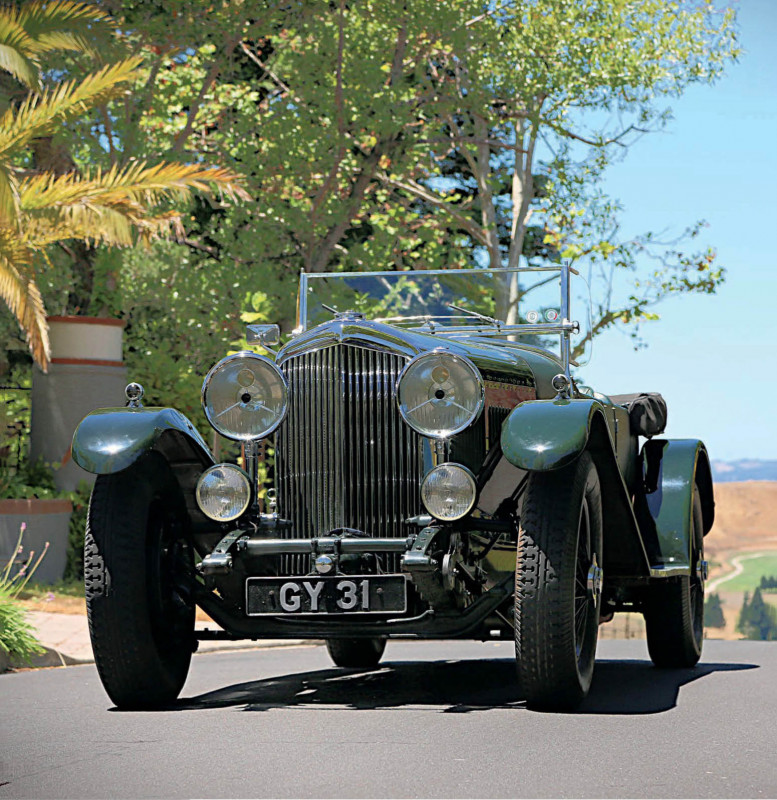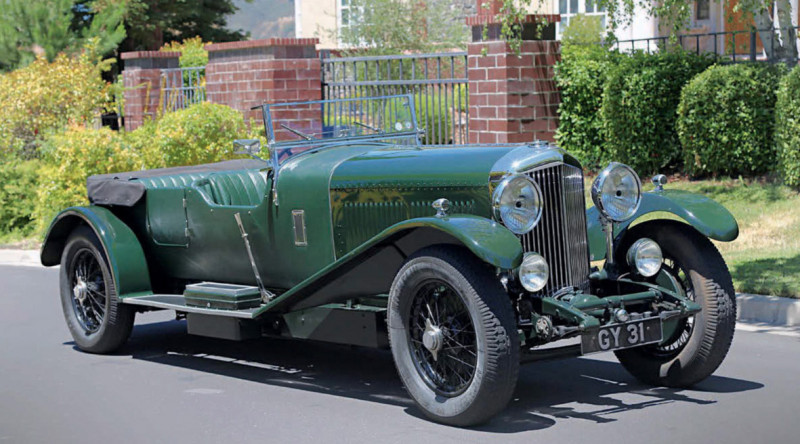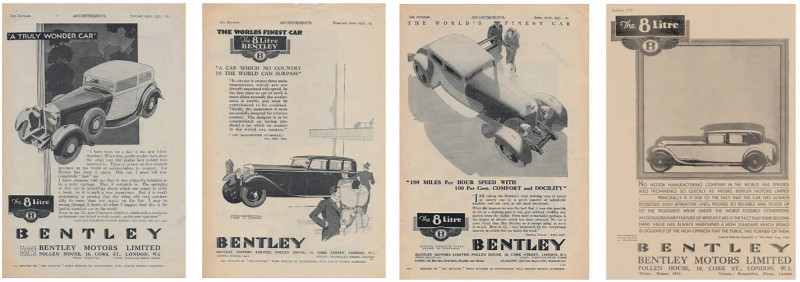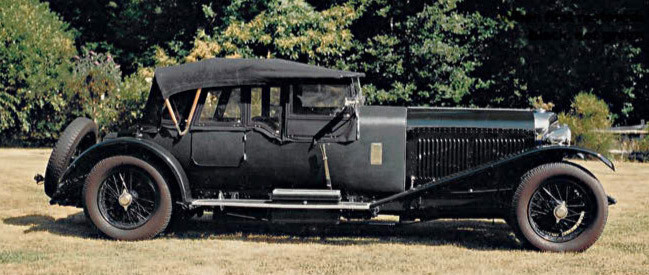1931 Bentley 8-litre
The 8-Litre ‘Dead Silent 100 mph car’ was W.O. Bentley’s masterpiece, in the view of many observers. Because they were made in tiny numbers, any encounter with an 8-litre is to be savoured, as our man in California, Steve Natale, discovered.
WORDS & PHOTOS: STEVE NATALE
8.0-LITRE THUNDER BIGGEST, BOLDEST, BEST?
100 miles per hour speed with 100 percent comfort and docility’ This proclamation was made in an advertisement that appeared for the Bentley 8-Litre in the April 17th, 1931 issue of The Autocar magazine, touting the performance of what Bentley claimed was ‘The world’s finest car’. Nearly a century later, many enthusiasts agree. This is a bold statement, especially when in 1931 cars like the Duesenberg, Rolls- Royce Phantom ll, Hispano-Suzia H6C 8-Litre, Cadillac V-16, and several other magnificent automobiles were being made. The 8-Litre was W.O. Bentley’s finest grand tourer. It was also the last car he designed for Bentley Motors.

“The 8-litre ‘Dead-Silent 100mph Car’ was W.O. Bentley’s masterpiece”
In the 1920s, W.O. Bentley’s cars had earned a solid reputation and were highly competitive in sporting events, including the first win at the 24-hour Le Mans race for a British car in 1924 and subsequently winning four more times before 1931. Despite impressive racing triumphs, by the end of the 1920s the finances of Bentley Motors were precarious indeed. The company was still not able to sell enough cars for a high enough price to make a profit. There was already a large number of manufacturers battling in the market for smaller and cheaper cars, but as far as Britain was concerned there was only one real competitor for the ultra-luxury market: Rolls-Royce. For 1930, Bentley aimed to create a faster, better handling luxury car than the Rolls-Royce Phantom II by producing what many historians consider his engineering masterpiece, the mighty 8-Litre.
AT THE HEART OF THE 8-LITRE
The 8-Litre represents an evolutionary step in the development of the Bentley engine, combining proven features of the 6 1/2-Litre model with the latest engineering advances. W.O. never liked the legendary ‘Blower’ Bentleys developed by Sir Henry ‘Tim’ Birkin, thinking it corrupted his engine design and added to much stress to the components. ‘Every engine we built was conceived with an eye first on reliability,’ Bentley explained, ‘then on smoothness and silence, and lastly on sheer power output. Of course, we were after power output, but not by any falsely induced means; and I always held that the supercharger applied to the Bentley engine was a false inducer. [It] was against all my engineering principles.’

GY 31 has worn this touring body for 45 years. The original saloon body is shown below.
History would him prove right, as the Blower Bentleys proved unreliable in many races. Rather than trying to squeeze more power from the existing 6ó-Litre engine, W. O. Bentley followed his long-preferred method of improving performance and simply enlarged it, increasing the bore size from 100 to 110mm. The engine utilized an overhead camshaft driven by a Bentley patented ‘three-throw drive’ system of triple connecting rods, plus, as with all earlier Bentleys, four valves per cylinder and twin-spark ignition (coil and magneto), which were state-of-the-art at the time.
“...it is somewhat difficult to believe that its transformation and restoration was completed nearly 45 years ago.”
THE 8-LITRE INTRODUCED
Announced on September 15th 1930 and launched at the London Olympia Motor Show in October 1930, the car competed head-to-head with Rolls- Royce's Phantom ll. The engine was just as quiet, the ride just as comfortable, the coachwork could be created to whatever the customer desired and, perhaps most importantly from a prestige point of view, it was faster. Bentley claimed the car was capable of achieving up to 125 mph with a guaranteed top speed of over 100 mph. At the time of the 8-Litre’s launch, W.O. declared, ‘I have always wanted to produce a dead silent 100mph car, and now I think we have done it.’

Such was the power of the car’s massive straight-six engine that the company guaranteed the 100mph mark regardless of the chosen coachwork – a remarkably bold step. In December of 1930, The Autocar magazine recorded a ó-mile terminal speed of 101.12mph in a Bentley 8-Litre, describing ‘motoring in its very highest form’ and ‘tremendous performance’. Between 1930 and 1939, Britain's foremost motoring magazine bettered that figure only once, while testing an Alfa Romeo 8C 2300.

Interestingly, the very same car was tested again by The Autocar on April 4th, 1954, and it was still capable of 100mph. The 8-Litre remained the fastest production Bentley until the R-Type Continental's arrival in 1953. Famous car collector Jay Leno owns an 8-Litre saloon and also claims to have exceeded 100 mph in his example.
END OF AN ERA
The 8-Litre was intended for the very wealthiest segment of the world's automotive buyers. Unfortunately, The Great Depression began to take effect and the market for luxurious cars had waned. Bentley's finances had been shaky for many years and Woolf Barnato, the firm’s financial backer in the late Twenties and three-time Le Mans winner in a Bentley, was forced to contribute more money on several occasions. Rather than ease the company's financial worries the 8-Litre only exacerbated them. Only 100 of these magnificent machines were produced, and the company was placed into receivership just 13 months after its introduction.

When first restored: black, not green.Car's immense wheelbase is disguised by good proportions.
CHASSIS NO. YX5109
This 8-Litre was delivered new to London's famed agency of Jack Barclay Ltd. wearing formal Sedanca de Ville Coachwork by Freestone & Webb. Given the timing of its purchase by the first recorded owner, G. Henscher, as mid-1932, it seems likely that perhaps the car was used by Barclay staff as a demonstrator. Michael Hay's book on the model notes that prior to acquisition by Henscher the car had already covered more than 2,400 miles and that when sold, it was sold as 'second-hand' and was to receive a new rear glass, and a full structural service of the bodywork and a polishing by Freestone & Webb prior to its delivery. The car continued to be maintained by the factory until just before the war.

The known ownership history of chassis YX 5109 is relatively uncomplicated, the car being the property of Joseph Perry of Birmingham just before the war and remaining with him until 1947 when acquired by Col. Walton, at which point it is known to have spent some time in Scotland. In 1962 the car was the property of a Willy P. Dale and later traded through Dan Margulies to Barry Eastick.
YX 5109 was restored in the 1970s by Hoffman and Mountford, at which point it was rebodied in the guise of the earlier 4ó and Speed Six 'Le Mans' fabric touring bodies, a style which was famously only fitted to one 8-Litre car.
James Pearce's eye for a good-looking sports tourer was arguably second to none and the bodywork fitted to this car is extremely well designed, in that despite retaining its original 13 ft chassis, the length of the car is obscured in its good proportions. The entire process took over two years from 1974 to 1976 at a cost of close to $30,000 — a tremendous price for a restoration at the time. On its completion it was shown at the Bentley Drivers Club Dorchester House meet in 1978 and later at the Kensington Gardens meet, in the 1980s. Soon afterward, YX 5109 made its way to America and was acquired by Bill Chadwick of Dallas, Texas. Chadwick showed the car at the RROC Regional Meet in Salado, Texas in 1986. In 1988 the 8-Litre was sent to Elmdown Engineering and received a full engine rebuild with new shell bearings, a Phoenix crankshaft and rods and fullflow oil filter. Later, a Laycock heavyduty overdrive was also fitted, allowing effortless touring at high speeds. The 8-Litre was later acquired by Charles H. Brown in 1995. Brown brought it back to his coach-house in the UK until 2013, where it was driven sparingly and well maintained during his 18-year stewardship, including a thorough service by Elmdown. Since 2013 the big Bentley was carefully maintained in a private collection before coming to the Blackhawk Collection in California, where it resides at the time of writing.
DRIVING IMPRESSIONS
Before I share my own opinions from behind the wheel, I had an opportunity to ask noted Rolls-Royce and Bentley expert and author of the book Superfinds, Michael Kliebenstein, about his experiences driving an 8-Litre: ‘Handling an open 8-litre Bentley in city traffic initially feels a bit like manoeuvring a torpedo gunboat in the close confines of Monaco harbour!
It wants to run wide, but at the same time feels restrained and majestic in any surroundings. The burbling soundtrack indeed very similar to a Second World War gun boat. Steering is heavy, but not as heavy as say, a Mercedes-Benz SS Kompressor of the same period. And nowhere near as nimble as a Bugatti Type 43A or Alfa 8C. Nevertheless the 8-litre is a fast old thing — very fast indeed.

‘There is something special about entering a modern motorway in a W.O. Bentley. As is common with the 4 ½ -litre Blower or 6 ½ -litre Speed Six, with the 8-litre Bentley you immediately enter the fast lane in 3rd gear and start overtaking anything in sight. Simply because you can. Roaring past lesser traffic you change reluctantly into 4th gear showing just 1800 revs on the huge plate-sized tachometer.’
‘You‘re doing something like 90mph average with no hint of overstretching the mechanics. 100mph can be easily achieved when pushed, but by then the wind is blowing your head off. I have to say that I prefer the 8-litre to the 4 ½ -litre Blower. Simply because the 8-litre feels so much more relaxed and powerful. The natural torque of the huge in-line six always gets me.’ Given the cosmetic condition of the car it is somewhat difficult to believe that its transformation and restoration was completed nearly 45 years ago, as the car still presents extremely well.
Almost a half a century of age and use has graced it with a soft patina. I was able to drive this machine a short distance up and down some hills. I was impressed with the torque and power of the engine. First gear was not needed, even from a dead stop going uphill. The long wheelbase of the car makes a 3-point turn into a 6-point turn, but this is not a car to zip around town in — it yearns for the open road. Looking down the long hood, glancing at the wooden dashboard packed full of gauges, clutching the big steering wheel while massaging the gearbox into its next gear, the 8-Litre is a truly incredible machine. W.O.’s last and greatest creation at the company that bears his name will remain one of the most coveted cars of all time.
TECHNICAL DATA 1931 Bentley 8-litre
- ENGINE: 7983cc straight-six, single overhead camshaft, four valves per cylinder, dual-ignition, Twin SU carburettors
- GEARBOX: Four-speed with constant mesh third.
- BRAKES: 400mm. drums with vacuum servo assistance
- STEERING: Worm and sector
- WHEELS: 21-inch well base rims with 700 x 21-inch tires
- TOP SPEED: 104 mph


